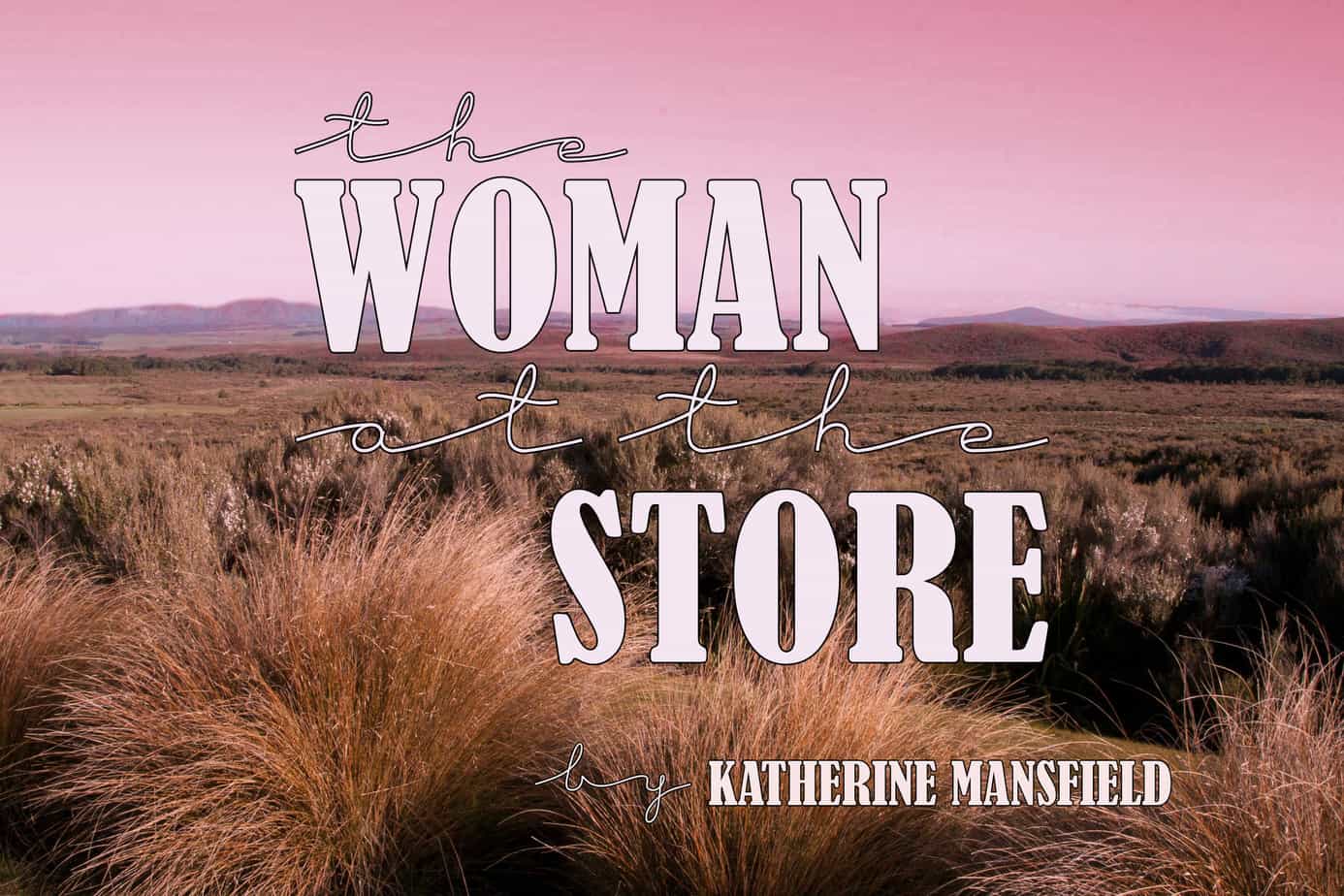“The Woman At The Store” (1912) is one of Mansfield’s earlier stories, written for the magazine Rhythm. The aesthetic goal of this magazine was pity, brutality and a carefully wrought plot with adequate foreshadowing. It is now thought that this story is far from Mansfield’s best work.
This short story has been criticised for its foreshadowing, considered ‘telegraphing’ (foreshadowing which is far too blatant).
When Mansfield writes ‘It sounded a ridiculous arrangement’ (in regards to the sleeping set-up), this sounds like a contrivance to fit the story — a writing hack otherwise known as ‘lampshading‘.
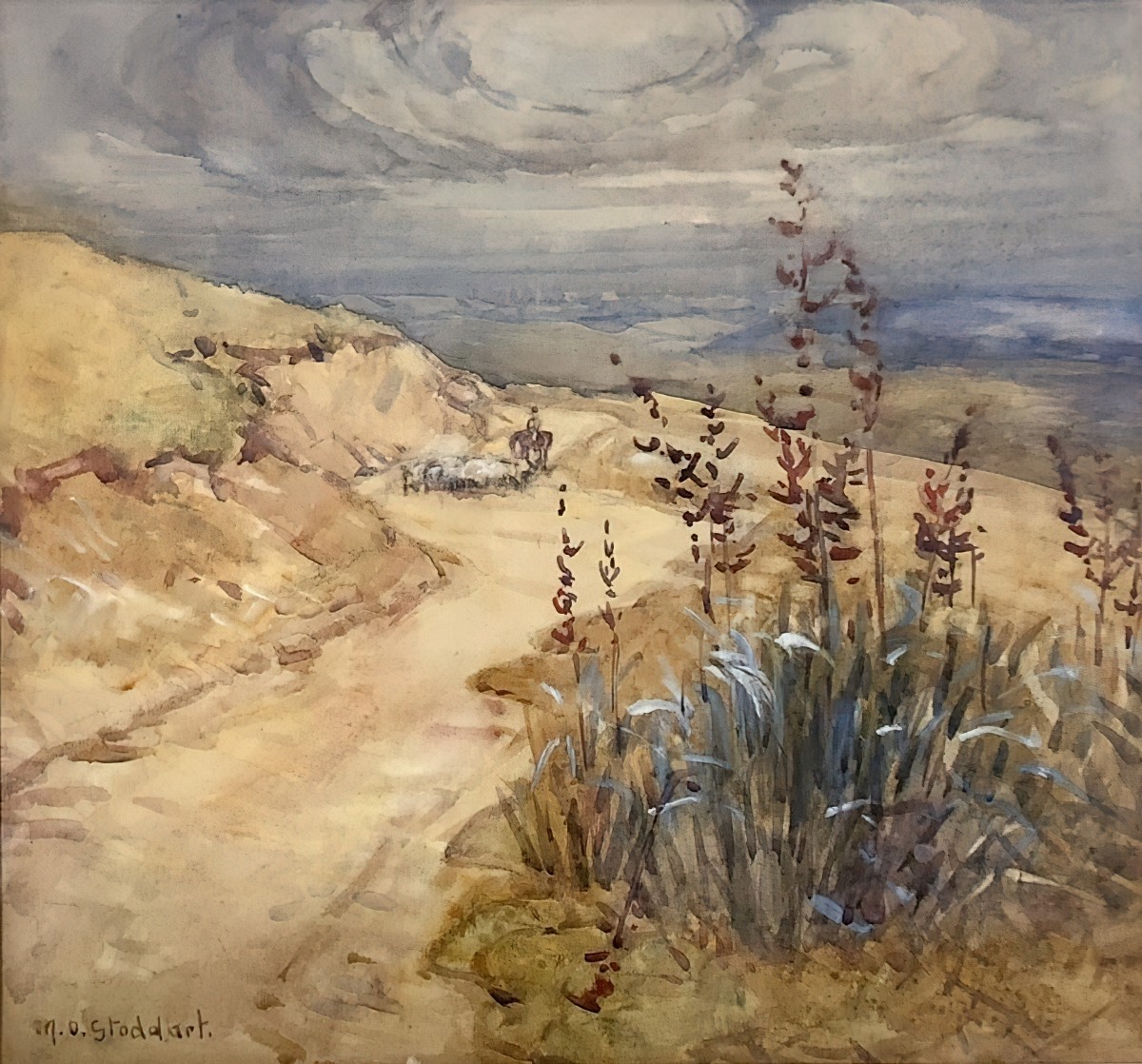
What Happens In “The Woman At The Store”?
Three people make a journey on horseback through the rough New Zealand country. The narrator, her husband and a brother. (Not sure from which side.) They come across a house where a woman is living with her five-year-old daughter.
The travellers stop for the night. One of the party — Jo — wants to have sex with the woman who runs the store. Despite her haggard appearance (or perhaps because of it, who knows), he makes arrangements to spend the night with her.
The daughter is sent to sleep inside the store with the narrator and her husband. Later, the daughter reveals through a drawing that the mother has killed her husband.
The next morning the narrator and Jim leave. Jo, left behind, shouts to them that he will catch up.
Setting of “The Woman At The Store”
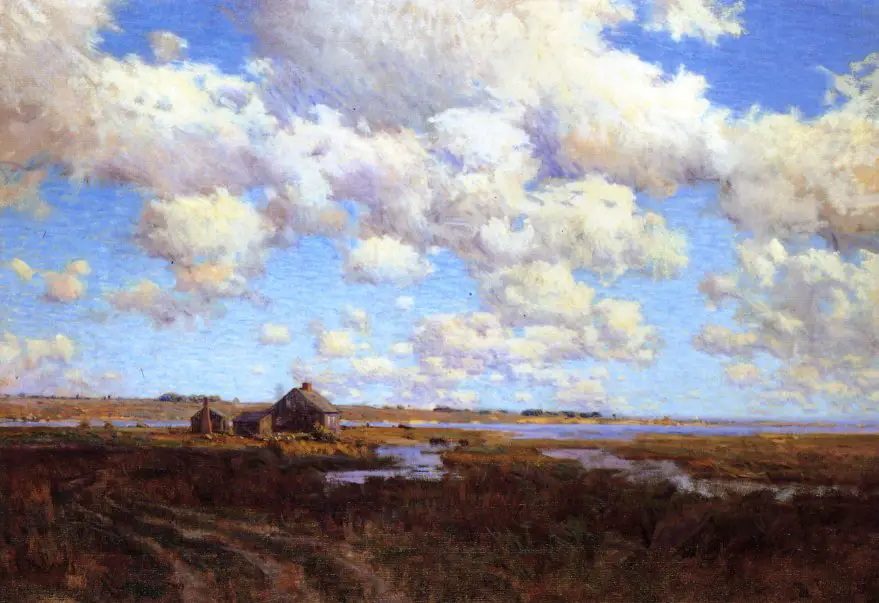
The woman at the store remains unnamed. She remains ‘other’ to them, and the worst kind of other to Jo, who does not acknowledge her as attractive in any meaningful way, yet still wants to do sex to her. (Not necessarily ‘with’.) Despite living in a whare, she has blue eyes and yellow hair. (Was her former husband Maori?) Her front teeth are ‘knocked out’ (rather than rotted out). Her former husband was almost certainly abusive.
There’s plenty of bird imagery running throughout this story. Mansfield did love a good bit of bird symbolism. And the child is described as a ‘rat’, same as The Kelvey Girls in “The Doll’s House“.
The season is midsummer. I’d guess January, which is (historically) about the only time New Zealand can get oppressively hot. (It’s more the humidity which makes a bit of heat unbearable.) Throughout this story Mansfield makes the most of extreme weather conditions:
Rain whipped in our faces, the land was light as though a bush fire was raging.
Some have said this is melodramatic, and blatant pathetic fallacy to boot. I figure that’s what this is: a melodramatic ghost story pastiche. The wild weather might be a form of magical realism.
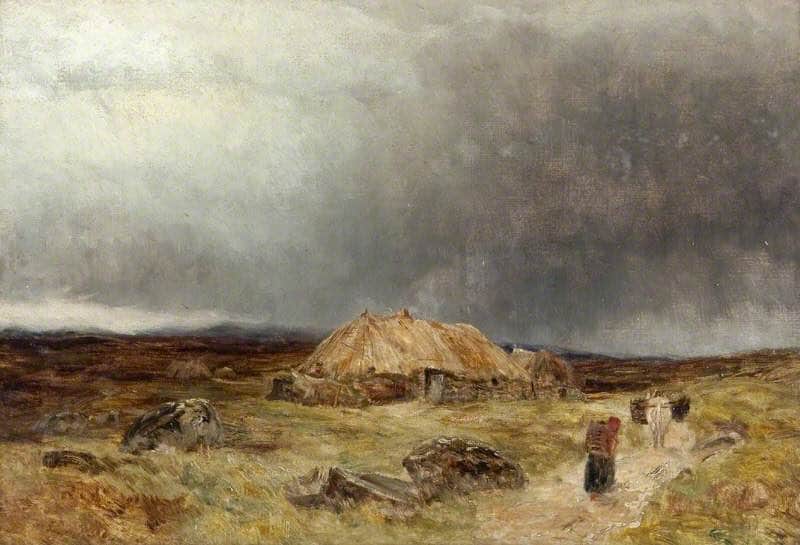
Narration of “The Woman At The Store”
Much has been said about the ‘naturalistic technique’ of this story. The syntax and word choice (especially the strong verbs) do create an oppressive atmosphere.
Unfortunately, the narrator intrudes, and breaks the spell. Details are not left to speak for themselves. Mansfield gives readers a bit too much help.
Hundreds of larks shrilled; the sky was slate colour,
and the sound of the larks reminded me of slate pencils scraping over its surface.
POINT OF VIEW
Alongside “The Young Girl”, some critics think “The Woman At The Store” would have been better if cast in another point of view. In “The Woman At The Store”, there is no argument to justify use of first person. Interestingly, we are unable to imagine her gender until a feminine pronoun is used much later in the story. (Is this deliberate? In many ways, Mansfield was herself gender non-conforming.) Unlike Mansfield’s other female main characters, who tend to be feminine and narcissistic, this one feels like ‘one of the boys’.
However, I’m guessing Mansfield had a good reason to write in first person. I think she’s writing a New Zealand ghost story. In that case, first person lends the verisimilitude of eyewitness account.
DIALECT AND SPELLING
It is no longer considered acceptable to change the spelling of words to mimic lower-class speech. This is generally thought condescending. In contemporary fiction, dialect comes only from syntax.
GLOSSARY OF “THE WOMAN AT THE STORE”
- a blue galatea shirt — a white cotton fabric with blue stripes
- wideawake — a type of hat, resembling that worn by a Quaker in colonial America, with a broad brim and black or brown felt
- jaeger —Jaeger is a United Kingdom based high-end fashion brand and retailer of menswear and womenswear formed in 1884
- duck trousers —The duck trousers get their name from the material from which they are made, a linen or cotton fabric that is finer and lighter than canvas. While occasionally used for men’s clothing, generally, the fabric is used for the lighter sails of vessels and the sacking of beds.
- fly biscuits — I’m at a loss here, but the fly biscuits I grew up with in New Zealand (in the 1980s) were named so due to the sultanas, which look like dead flies.
- whare — a house
- bluchers — ankle-length, front-laced shoes. (Your bog standard lace up. Your ‘holotypic‘ men’s lace up.)
- embrocation — an old-fashioned word for liniment, which is also quite old. What do the young folks say now? Ointment? Lotion? Rub? Fudge?
- Pawa — is now spelt paua, after standardisation of Maori spelling. The paua is a large, edible abalone, native to New Zealand.
- Richard Seddon — the Prime Minister of New Zealand 1893-1906. He took strong measures to try and stop New Zealand women from winning the right to vote. He refused to retire despite strong encouragement, then died in office age 60. All this aside, he remains much revered, and the woman at the store obviously revered him, too. She would’ve had an affinity with a man who himself ran a pub before becoming a full-time politician. Was Mansfield commenting on any of this?
- Sundowner — now the breed of a popular Australian apple. But in Mansfield’s time, in New Zealand, it referred to a tramp who habitually seeks out accommodation each day around sundown.
- Beano — short for bean-feast, a British colloquial term (1875-1940?) for an excursion or celebration with food and drink
- Rook rifle — an obsolete English single-shot small calibre rifle intended for shooting small game e.g. rooks and rabbits. Rooks are a gregarious Eurasian crow with black plumage and a bare face. (Rabbits were brought to New Zealand from the 1830s onwards, for food, sport… and total decimation of the landscape. Rooks were introduced in the 1860s to make European immigrants feel more at home, and later had to be brought under control because they were doing too well.)
STORY STRUCTURE OF “THE WOMAN AT THE STORE”
There’s a whole category of ghost stories about travellers who stumble upon an eerie place, interact with characters, then leave, never to find that same place again. In others, characters never leave because the house (or motel/hotel doesn’t let them go). For the second category of tale see for example “The Bus” by Shirley Jackson. (I think Jackson made a better supernatural writer than Mansfield did. “The Bus” is one masterful story. Mansfield was very much at home in whatever you call “Prelude”: social realism with strong imagistic patterns?)
Anyhow, that’s how “The Woman At The Store” reminds me of a ghost story. Two of the characters escape but the house swallows the other one. The ‘whole place disappears’ as two of the party round the bend. We might take that literally, as in, the store no longer exists because there’s no one there to see it. (Jo could have been a ghost already, when he waved goodbye.) For a picture book example of this story see Norton’s Hut by John Marsden and Peter Gouldthorpe. Unfortunately it’s a little hard to get now, but would make a great classroom introduction to this short story.
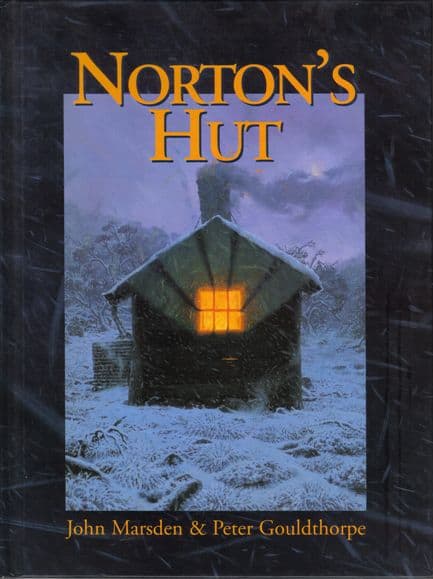
When a young group of hikers gets lost in a blinding snow storm they find shelter in an abandoned hut. Inside the hut they find a man who ignores them and by morning has disappeared. After they are rescued, they question whether the strange events really occurred.
Marsden and Gouldthorpe’s picture book is only understood after reading the pictures as well as the words. In Mansfield’s short story we have no pictures, but plenty of detail which paints an ominous picture:
- flies
- the twilight which ‘frightens, as though a savage spirit of the country walked abroad and sneered at what it saw’.
- The image of the bottles and pickles in a room all lined up has a horror feeling to it — as if the pickles might actually be body parts or something.
- “She’s the dead spit of me!”
- The landscape is described as alive: ‘I went to the end of the paddock where the willows grew and bathed in the creek. The water was clear and soft as oil. Along the edges held by the grass and rushes, white foam tumbled and bubbled.’
- The kid did not utter a cry.
- she stood in her grey flannel night-gown
SHORTCOMING
Three travellers (two men and a woman) need somewhere to stay for the night. It has been a long, hot day, their pack horse is in need of medical attention and their own basic needs must be met.
Jo has stopped singing, which tells us the party is not in good spirits.
DESIRE
The three travellers want food and a bed for the night. Jo wants to have sex with a woman, any woman, and this one will do.
OPPONENT
The woman at the store has everything they need, but isn’t willing to give it easily.
The child doesn’t want to sleep with two strangers, which is completely fair enough. How many parents would let their five-year-old bed down with strangers? The child ends up an ally, really, for telling them the truth of the situation, but for the duration of the story, this is the Creepy Child with the Nightmare Fuel Colouring Book.
PLAN
They plan to sweet talk her, but this isn’t necessary as the woman at the store comes around in her own time.
BIG STRUGGLE
The child grows angry at being cast out into the store room and for this reason reveals that the mother killed the father with a gun.
ANAGNORISIS
In lieu of a anagnorisis, there is a plot revelation (that the woman killed the man).
In the best short stories, a plot revelation is accompanied by a anagnorisis. That doesn’t happen in this one. As a bit of entertainment, “The Woman At The Store” is serviceable, but as a great work of literature… no. There’s only one layer to this one.
NEW SITUATION
As mentioned above, this story features the Inn of No Return trope. Those who check-in can never leave, then there’s this kind of story. In “The Woman At The Store”, two of the travellers do get out of there, but are forever changed by what they have learned. The other, who went right into the house and stayed the night with the woman, may be stuck there forever.
I’m sure he’s still there.
